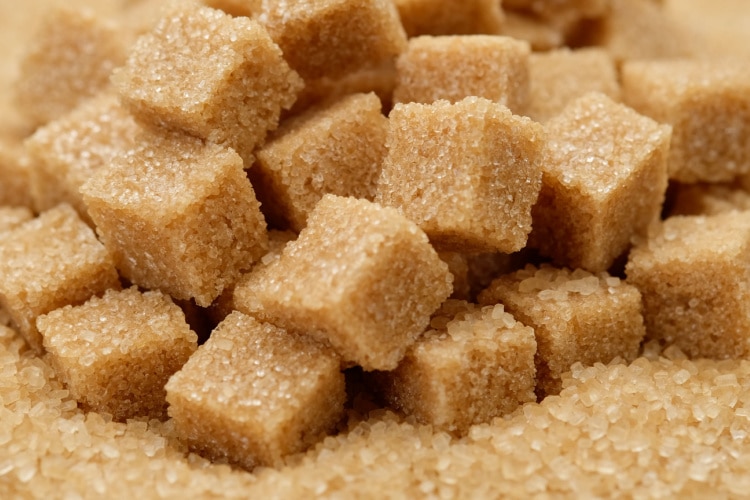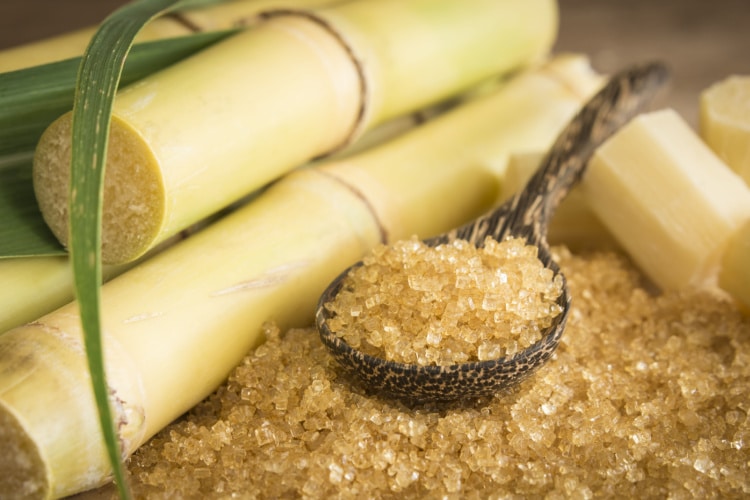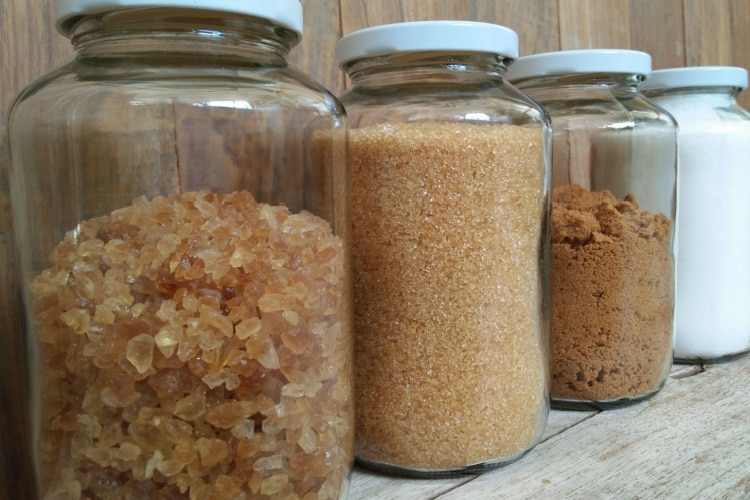Sugar cane is the go-to sweetener used in practically every baked good — it improves browning, texture, flavor, and aroma.
In this sugary article, we explain the difference between two types of sugars made from sugar cane which get easily mistaken for one another — cane sugar and brown sugar.
Although they look and feel eerily identical, we’ll see that their concentration of molasses is very different. So, let’s take a deeper look at what distinguishes these sugars.
Difference Between Cane Sugar and Brown Sugar
The main difference between sugar cane and brown sugar is the production process and the concentration of molasses. Brown sugar is created by mixing molasses with white sugar and contains around 6.5% molasses. Cane sugar already contains molasses residues from the refining process and usually has up to 14% of molasses.

Molasses is a thick, dark syrup-like substance created during the sugar-making process. During this process, the sugar cane is crushed, and the juice is extracted and heated. Once the sugar crystals begin to form, they are removed from the liquid, and the leftover syrup is what we call molasses.

Cane sugar is made from sugar cane. There are three types of cane sugar, each with a different level of molasses concentration:
- Unrefined cane sugar: This sugar is refined very little, keeping 8 to 14% of molasses
- Raw cane sugar: Raw cane sugar is moderately refined and contains 2 to 3% molasses
- Refined cane sugar: As the name suggests, this type of sugar is fully refined sugar with no molasses (this is the stage where molasses can be mixed back in to produce brown sugar)
Brown sugar is made from either sugar cane or beets. Brown sugar may be classified into two types depending on how much molasses is added back to the refined sugar:
- Light brown sugar: Contains a lower molasses content of roughly 3.5%
- Dark brown sugar: Contains a greater molasses content of roughly 6.5%
Besides the concentration of molasses, brown sugar and cane sugar also differ in flavor, texture, color, usage, price, and nutritional value. So let’s examine their distinctions and see whether there is a real frontrunner in this topic.
Texture: The molasses decide the sugar’s density, heaviness, and moisture. Sugars with higher molasses concentration are more granular as opposed to those with less. That being said, refined cane sugar has the finest texture. Raw cane sugar has medium-coarse crystals, and unrefined cane sugar and brown sugar contain the largest crystals.
Color: Unrefined cane sugar is dark brown, raw cane sugar is golden-brown, whereas refined sugar is white. As the name suggests, light brown sugar has a light-brown color that resembles raw cane sugar, while dark brown sugar is quite similar to the color of unrefined cane sugar.
Taste: Both cane sugar and brown sugar are sweet, although the sweetness level depends on the quantity of molasses present, and each variation may have a different flavor character. The sweetest sugars are dark brown sugar and unrefined cane sugar, often described as having a caramel flavor. Both raw cane sugar and light-brown sugar have a slight vanilla-like taste. Refined cane sugar has the familiar sweetness of regular sugar.
Cooking usage: Cane sugar may be used right out of the package and requires no additional treatment. It’s used in recipes for cookies, ice cream, caramel syrup, cakes, and other sweets. Cane sugar melts at high temperatures, making it the perfect glaze for meat recipes. It may also be used as a garnish on the top of cookies and cupcakes to add crunch.
Like cane sugar, brown sugar can be used straight from the box and doesn’t need any particular prep. When measuring brown sugar, push it down firmly in the measuring cup since it has more moisture. Brown sugar gives pies, cakes, puddings, cookies, and muffins a faint caramel flavor. It also gives baked foods extra moisture.
Brown sugar is used as a crispy topping over puddings and cookies due to its larger crystals. In salad dressings and vinaigrettes, brown sugar is used for its pleasant sweetness. It gives a smoky BBQ sauce balance in taste. When added to coffee, brown sugar makes a suitable substitute for processed cane sugar. It may also be used as a glaze on meats, like cane sugar.
Cane Sugar vs. Brown Sugar Comparison Table
| Category | Cane Sugar | Brown Sugar |
| Type of plant | Sugar cane | Sugar cane or sugar beets |
| Presence of molasses | Natural molasses | Added molasses |
| Types | Unrefined: 8 to 14% of molasses Raw: 2 to 3% molasses Refined: 0% molasses | Light-brown: 3.5% molasse Dark-brown: 6.5% molasses |
| Texture | Unrefined: large crystals Raw: medium crystals Refined: fine crystals | Large crystals, bigger than cane sugar |
| Color | Unrefined: dark-brown Raw: light-brown Refined: white | Light-brown and dark-brown |
| Taste | Unrefined: the sweetest Raw: medium sweetness Refined: basic sweetness | Light-brown: the sweetest Dark-brown: medium sweetness |
| Cooking usage | Used right out of the package. Included in cookies, ice cream, caramel syrup, cakes, and glaze for meat recipes. It may also be used as a crunchy garnish on top of cookies and cupcakes. | Used straight from the box. It adds moisture and more caramel flavor to pies, cakes, puddings, cookies, and muffins. Used as a crispy topping over puddings and cookies. It’s included in salad dressings, vinaigrettes, and BBQ sauce. It’s a cane sugar substitute in coffee and as a glaze on meats. |
Nutritional Content Breakdown: Which One Is Healthier?
We can observe from the nutritional profile that white (refined) cane sugar contains the most calories. Aside from this minor distinction, all sugars are chemically the same. Hence no sugar is better than the other.
White Vinegar vs. White Wine Vinegar: Nutritional Profile
| Category (1 tbsp) | Calories | Carbs | Sugar |
| Refined cane sugar | 16.3 | 4.2g | 4.2g |
| Raw cane sugar | 15 | 4g | 4g |
| Unrefined cane sugar | 15 | 4g | 4g |
| Light-brown sugar | 15 | 4g | 4g |
| Dark brown sugar | 15 | 4g | 4g |
Can I Substitute Cane Sugar for Brown Sugar & Vice Versa?
Cane sugar and brown sugar have few differences in culinary applications, so in any recipe that calls for brown sugar, you may substitute cane sugar.
With refined cane sugar, the dish will still be sweet, but it won’t have that warm and somewhat smokey flavor of molasses. Plus, the color will be paler. Use a 1:1 ratio when substituting for one another.
Use brown sugar and unrefined cane sugar if you like a stronger flavor and more color in your food. White cane sugar is the best option if you like a sweet flavor without the kick of molasses. Additionally, acceptable replacements are honey, simple syrup, corn syrup, and coconut sugar.
Storage & Shelf Life

Since sugar can’t go bad, it has an endless shelf life – if stored correctly.
To maintain their moisture content, brown sugar, unrefined sugar, and raw cane sugar must be stored in an airtight container. If not, they could get harder as the fluid gradually dries off.
These sugars genuinely don’t have a shelf life as long as they are stored correctly. However, the quality is optimum when consumed within two years.
If the sugar becomes too hard, put a slice of bread in the sealed jar with the sugar. A slice of bread can soak the moisture from the sugar, restoring its natural texture. After a day or so, remove the slice of bread.
Buying Cane Sugar & Brown Sugar: Which One Is More Accessible?
Both cane sugar and brown sugar can be found in the baking section of any supermarket.
Refined (white) cane sugar is the most commonly accessible as every grocery shop offers it in the baking department. On the other hand, unrefined cane sugar may be harder to find, but specialist food stores will almost definitely have it. If not, you can always purchase it online from, say, Amazon.
The more organic the sugar, the more expensive it is and the more difficult it is to find. Unrefined cane sugar is in its purest, most unrefined form, so it’s more expensive than raw and refined cane sugar, as well as light and dark brown sugar.
Conclusion
This concludes our sugary discussion!
Both of these are excellent options with a variety of uses, particularly for baking. Both contain molasses, but in different proportions, and neither one is healthier than the other, despite the fact that refined (white) cane sugar has a little bit more calories.
Brown sugar can be swapped out for cane sugar and vice versa. If you desire a vanilla-like flavor, use raw cane sugar or light brown sugar. If you want to give your delicacies a caramel flavor, choose unrefined cane sugar or dark brown sugar.
amazon product link







